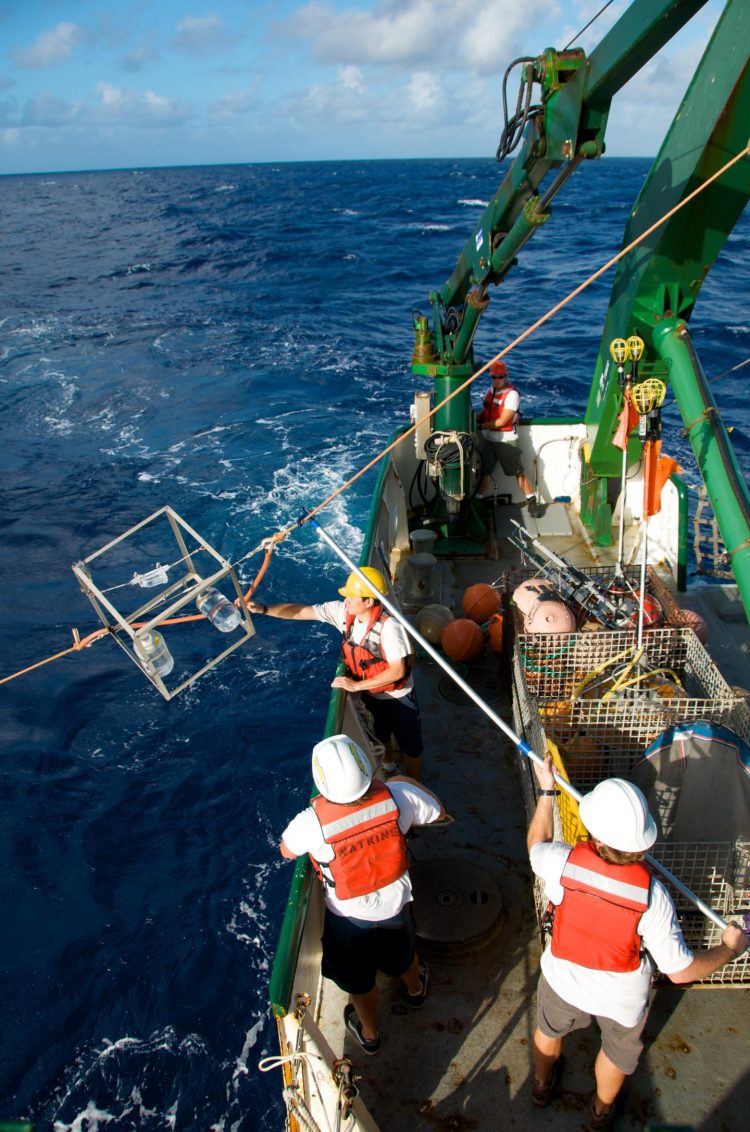Another human footprint in the ocean

Hawaii Ocean Time-series Program scientists work aboard the R/V Ka'imikai-O-Kanaloa in the North Pacific Ocean. The HOT Program provided decades of data used to reconstruct historical nitrogen concentrations. Credit: Paul Lethaby, UH SOEST
Human-induced changes to Earth's carbon cycle – for example, rising atmospheric carbon dioxide and ocean acidification – have been observed for decades. However, a study published this week in Science showed human activities, in particular industrial and agricultural processes, have also had significant impacts on the upper ocean nitrogen cycle.
The rate of deposition of reactive nitrogen (i.e., nitrogen oxides from fossil fuel burning and ammonia compounds from fertilizer use) from the atmosphere to the open ocean has more than doubled globally over the last 100 years.
This anthropogenic addition of nitrogen has reached a magnitude comparable to about half of global ocean nitrogen fixation (the natural process by which atmospheric nitrogen gas becomes a useful nutrient for organisms). David Karl, Professor of Oceanography and Director of the Daniel K. Inouye Center for Microbial Oceanography at the University of Hawai'i, teamed up with researchers from Korea, Switzerland and the U.S. National Oceanic and Atmospheric Administration to assess changes in nitrate concentration between the 1960s and 2000s across the open North Pacific Ocean.
Their analysis, which could discern human-derived nitrogen from natural nitrogen fixation, revealed that the oceanic nitrate concentration increased significantly over the last 30 years in surface waters of the North Pacific due largely to the enhanced deposition of nitrogen from the atmosphere.
“This is a sobering result, one that I would not have predicted,” said Karl. “The North Pacific is so vast it is hard to imagine that humans could impact the natural nitrogen cycle.”
The researchers used ocean data in conjunction with the state-of-the-art Earth System Model to reconstruct the history of the oceanic nitrate concentration and make predictions about the future state of the North Pacific Ocean. Their assessment revealed a consistent picture of increasing nitrate concentrations, the magnitude and pattern of which can only be explained by the observed increase in atmospheric nitrogen deposition.
Enhanced nitrogen deposition has several potential ecological ramifications. Because biological activity is limited by nitrate availability in the North Pacific Ocean, the input of new nitrogen from the atmosphere may increase photosysnthesis in the sunlit layers and export of carbon-rich organic material out of the surface ocean into the deep.
“The burgeoning human population needs energy and food – unfortunately, nitrogen pollution is an unintended consequence and not even the open ocean is immune from our daily industrial activities,” said Karl.
Given the likelihood that the magnitude of atmospheric nitrogen deposition will continue to increase in the future, the North Pacific Ocean could rapidly switch to having surplus nitrate. Thus, past and future increases in atmospheric nitrogen deposition have the potential to alter the base of the marine food web; and, in the long term, the structure of the ecosystem.
In particular, the shift in nutrient availability could favor marine organisms that thrive under the high nitrate and low phosphorus conditions. If similar trends are confirmed in the Atlantic and Indian Oceans, it would constitute another example of a global-scale alteration of the Earth system. Further, the findings of this study of the North Pacific highlight the need for greater controls on the emission of nitrogen compounds during combustion and agricultural processes.
This research was supported by the Korean National Research Foundation of Ministry of Science, ICT and Future Planning, Science and Technology (Global Research Project), through a novel collaboration between scientists at Pohang University of Science and Technology and the University of Hawai'i. David Karl's participation was also supported by the U. S. National Science Foundation and the Gordon and Betty Moore Foundation through grants GBMF480.01 and GBMF3794.
I-N Kim, K Lee, N Gruber, D M Karl, J L Bullister, S Yang, T-W Kim (2014). Increasing anthropogenic nitrogen in the North Pacific Ocean. Science
Media Contact
More Information:
http://manoa.hawaii.edu/All latest news from the category: Earth Sciences
Earth Sciences (also referred to as Geosciences), which deals with basic issues surrounding our planet, plays a vital role in the area of energy and raw materials supply.
Earth Sciences comprises subjects such as geology, geography, geological informatics, paleontology, mineralogy, petrography, crystallography, geophysics, geodesy, glaciology, cartography, photogrammetry, meteorology and seismology, early-warning systems, earthquake research and polar research.
Newest articles

Silicon Carbide Innovation Alliance to drive industrial-scale semiconductor work
Known for its ability to withstand extreme environments and high voltages, silicon carbide (SiC) is a semiconducting material made up of silicon and carbon atoms arranged into crystals that is…

New SPECT/CT technique shows impressive biomarker identification
…offers increased access for prostate cancer patients. A novel SPECT/CT acquisition method can accurately detect radiopharmaceutical biodistribution in a convenient manner for prostate cancer patients, opening the door for more…

How 3D printers can give robots a soft touch
Soft skin coverings and touch sensors have emerged as a promising feature for robots that are both safer and more intuitive for human interaction, but they are expensive and difficult…




















